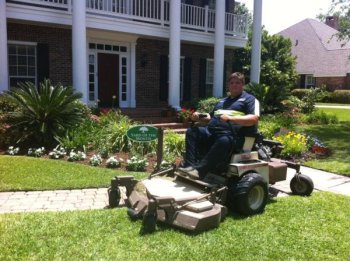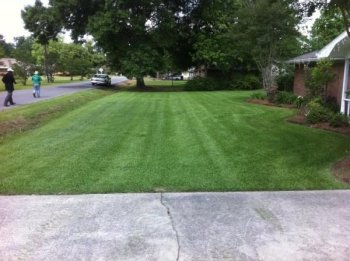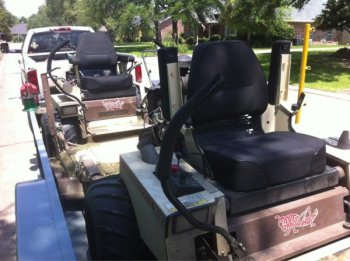
"Who says St. Augustine grass won't stripe?"
May 15, 2012
In the Deep South, the majority of turf grasses include varieties of St. Augustine, Centipede and Bermuda. These warm-season grasses, while drought-resistant and tough, are notorious for aggressive growth and their profound ability to resist the striping methods of local landscape maintenance professionals. But who says St. Augustine wont stripe, says Jonathon Abrahams, owner of Groundskeeper, LLC, a full-service landscape maintenance company in Lake Charles, La. Its not like those stripes you get with cool-season grasses up north, but you can make them look good if you just do it right. Abrahams says he does not use any special tools or striping kits, and there are no tricks or gimmicks, just knowing how to read the lay of the property to get the best lawn stripes. But the most important factor for him is the mowing equipment. I have two Grasshopper mowers, a 329B MidMount and a 729BT FrontMount, both powered by Vanguard engines, and they cut like a dream, he says. Id put them up against anything else out there. No other mower can match them. There is just something about the mowing deck out-front that makes the cut so much crisper and cleaner, Abraham says. He says there is nothing like the 729BT on well-fertilized St. Augustine, and it has to do with the power, design and weight distribution of the mower and the flotation of the decks. Im 6 5 and 430 pounds, so Im a good-sized boy, but the FrontMount does a great job of evening the weight out and not leaving ruts or indentions in the yard, he says. I make sure to use that machine on all my high-end clienteles properties. Most of Abrahams clients are doctors and affluent homeowners who want their properties in pristine shape all the time. Most of the properties average one-half acre to one acre; he does have a few larger estates of five to six acres, as well as a private school that encompasses three city blocks. Not all of that is mowing, but all the properties require regular maintenance. Were full service, and we can do everything, including irrigation installation and repairs, he says. The Grasshoppers help us to get the best results, too. In fact, one of my clients just won Yard of the Month for the neighborhood, and its all because of the Grasshoppers. Not only do the mowers deliver the cutting results he and his clients expect, but they also provide the most comfort and long-term value for Abrahams. In fact, comfort is one of the most important factors for him sticking with Grasshopper. Ive ridden everything, and with my size, there is nothing as comfortable as these mowers. I love the comfort, says Abrahams. The seat is great. Its comfy and the material doesnt get hot in the summer sun. And, when he installed the wide-seat kit with the foldable armrests the 329B, he remarked that the best seat in the industry just got better. As for long-term value, Abrahams says you cannot find a more durable, versatile mower. He knows contractors who use other mower brands, and while they are waiting on parts because their mowers are down, he is out on his Grasshoppers making money. He is currently on his third and fourth Grasshoppers, and recalls the first one he bought back in 2006. It was brand new. I put 3,500 hours on it before I traded it in. I never had any trouble with it, he says. My dealer tells me that the guy who bought it says its still going and that he loves it. So these machines are built to last. Now, Abrahams is looking to the future, saying that his next Grasshopper will be a diesel, simply for fuel economy. He is not considering anything else but a Grasshopper, and with the success he has had so far, why would he?


